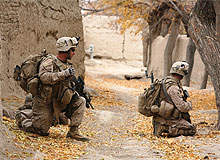
Many commentators and analysts are claiming that the war in Afghanistan is being lost to the Taliban and that western forces are locked in another Vietnam, with ignominious withdrawal their only prospect. But in 1975, the same year the US left Vietnam, the UK defeated a communist insurgency in Dhofar province of Oman. The residual acts of terrorism were finally brought to an end in March 1980, nearly 15 years after the first shots were fired.
The conflict began in 1965. The Maoist insurgents were winning up until 1970, the year of the UK-inspired palace coup that deposed Sultan Said bin Taimur in favour of his son, Qaboos bin Said Al Said. In these first five years, all that could have possibly gone wrong for the UK did so: there were insufficient "boots on the ground", no helicopters, no attempt at winning hearts and minds, inadequate rifles, machine guns, mortars, artillery and airpower, and no police or Special Branch.

Discover B2B Marketing That Performs
Combine business intelligence and editorial excellence to reach engaged professionals across 36 leading media platforms.
On top of this there was limited support from the UK; the Sultan’s Armed Forces (SAF) alienated the people and were perceived as the root cause of Sultan Taimur’s tyrannical rule; there was corrupt and inept governance; and civilian morale was "low to abysmal".
The People’s Front for the Liberation of the Occupied Arab Gulf exploited these failures and grievances. They were supported by the Marxist People’s Democratic Republic of Yemen and nearly all other communist countries of the time, with China placing the "liberation" of Oman and the Gulf States second only to the "liberation" of Vietnam.
People’s Front personnel were trained at the People’s Anti-Imperialist University in Beijing. North Vietnam dispatched advisers who specialised in the art of terror, and the "Adeera" murder squads provided the necessary skills in rape, torture and summary execution so as to persuade the Dhofaris that Islam was no longer of any validity in a world of radical left-wing politics.
Turning the tide

US Tariffs are shifting - will you react or anticipate?
Don’t let policy changes catch you off guard. Stay proactive with real-time data and expert analysis.
By GlobalDataBy the time of the coup, the People’s Front controlled the jebel (mountain range) near Dhofar and was attacking coastal towns daily. This included Salalah, now the second largest city in Oman, which was the home of the RAF base provided the only air support for ground troops venturing into the hills.
The protection of RAF Salalah was vital, and it was only achieved by the building of a line of protected sangars – a series of barricades known as "Hedgehogs" – across the Salalah plain. These were extended onto the jebel itself as part of Operation DIANA, a response to the enemy deploying katyusha multiple rocket launchers. The only route out of Salalah, northwards through the jebel, was also eventually secured on a permanent basis under Operation JASMIN.
In October 1971, it was wisely decided that the SAS should seize and hold a foothold on the jebel to the east. This was the prerequisite to building government offices, schools, water holes, vet centres, medical services and a small store. Gradually the eastern jebel was secured, and the SAS broken down into British Army Training Teams (BATTs). The BATTs were co-located with increasing numbers of surrendered enemy personnel, who were formed into local guard forces.
A major and daring plan – Operation SIMBA – was enacted in April 1972. A battalion group was deployed in the far west of Dhofar at the town of Sarfait, and tasked with closing the People’s Front’s resupply routes from People’s Democratic Republic of Yemen once and for all. Regrettably this was not possible; although the battalion group remained dug in at Sarfait for the next three years under constant artillery, mortar and rocket fire, the supply route remained open.
The next step was in the deployment of "stop lines" across the jebel to disrupt the camel supply trains, particularly the 53km Hornbeam line north of Mughsayl. The BATT at Mirbat came close to annihilation in July 1972 when around 300 adoo (as the enemy were known) mounted a major surprise attack – which was countered, just, with the aid of the Sultan of Oman’s Air Force and the chance arrival of a relieving SAS squadron.
By now Sultan Qaboos had gained the necessary support from his neighbours, notably Iran and Jordan. Both donated sizeable forces to strengthen the stop lines, freeing the SAF (now four battalions strong) for offensive operations further west. By late 1975 it was possible to put the cork back in the bottle at Sarfait and close off all resupply into Dhofar.
The enemy at bay
With Dhofar now secure, the Dhofar Development Department was given free rein. Although Sarfait remained under constant indirect fire until the end of March 1976, and terrorist attacks continued on a small scale for a further four years, the war was over.
Throughout this war, command at every level in the SAF down to second in command of rifle companies was vested in loan service and contracted UK officers. In comparison, the US-trained Iranians suffered dreadful casualties as a consequence of incompetent leadership and a complete failure to comprehend the nature of counterinsurgency. This the UK avoided.
The communist defeat demonstrated once and for all that the "historical inevitability" of Marxism was nothing of the sort. Oman has never looked back and has remained at peace ever since the defeat of the communists. Yes, there were sacrifices along the way, but these were a necessary consequence of the stand made by Sultan Qaboos and his UK-led armed forces.





